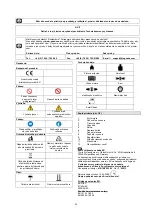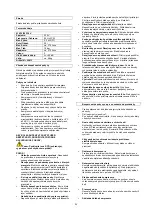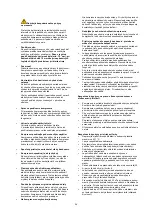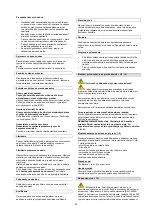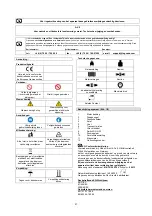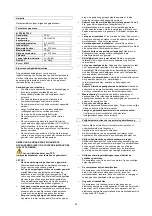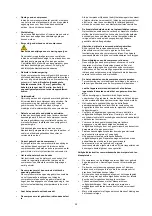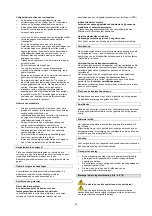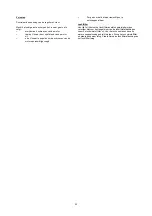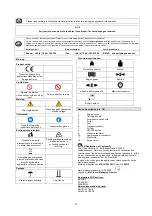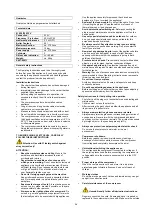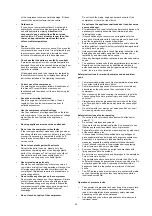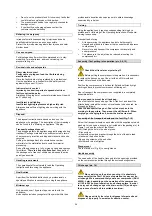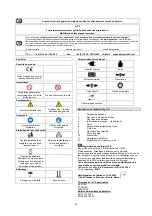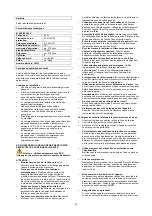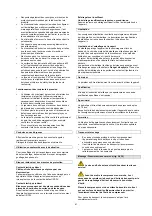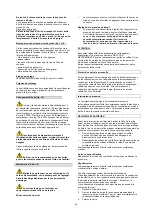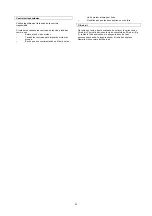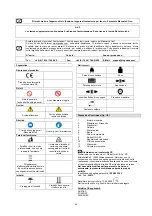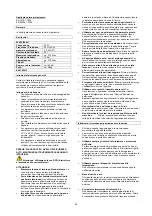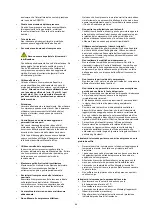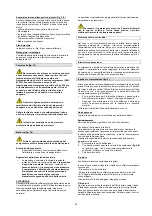
•
Do not use the pressure tank if it shows any faults that
could threaten employees or third parties.
•
The pressure tank needs to be regularly checked for
damage or rust.
•
If you identify any damage please contact the
customer service workshop.
Behaving in emergency
Introduce first aid corresponding to injuries and seek a
qualified medical person as soon as possible.
Protect the injured person against other injuries and calm
him/her down.
Use as designed
For blowing and soft works with compressed air, in clay-
modelling, for wall airbrush, airbrush varnishing, tire
pressure rating, etc.
Residual risks and safeguards
Direct electric contact
Faulty cable or plug can lead to a life-threatening
electric shock.
Have the faulty cable or plug replaced by a professional.
Use the appliance on a connector with a safety switch
against stray current (FI) only.
Indirect electric contact
Injuries by conductive parts at exposed electric or
faulty construction parts.
Always pull the plug out of socket at maintenance. Use with
an FI switch only.
Insufficient local lighting
Insufficient lighting represents a high safety risk.
Always ensure sufficient lighting when working with the
appliance.
Disposal
The disposal instructions are based on icons on the
appliance or its package. The description of their meanings
can be found in the “Marking on Appliance“ Chapter.
Transport package disposal
The package protects the appliance against damage during
transport. Package materials are usually selected in terms
of environment protection and disposal manner and can be
recycled.
Putting the package back into circulation saves raw
materials for the material and cuts costs for material
processing.
Parts of the package (e.g. foils, styropor) can be dangerous
for children.
There is a risk of suffocation!
Keep parts of
the package out of reach of children and dispose them as
quickly as possible.
Handling requirements
The operating staff must carefully read the Operating
Instructions before using the appliance.
Qualification
Apart from the detailed instruction by a professional no
special qualification is necessary for using the appliance.
Minimum age
Only persons over 16 years of age can work with the
appliance.
An exception includes youngsters if they work within their
professional education whose purpose is to obtain knowledge
supervised by a trainer.
Training
Using the appliance only requires corresponding training by a
professional or following of the Operating Instructions. No special
training is necessary.
Transport and storing
•
At longer storing, the appliance needs to be thoroughly
cleaned and placed in a manner that no unauthorised persons
could access it.
•
Never store and transport the compressor horizontally and
under pressure!
•
The pressure in the air jet can be reduced at cooling the
compressed air.
Assembly / first putting into operation (pic. 5-8, 10)
Check the oil level at every start-up!!!
Before putting the compressor into operation, it is necessary
to replace the transport peg of the oil with an oil fill mouth and
correct oil level needs to be ensured.
Position the compressor on a horizontal, flat and sufficiently high
working surface to prevent compressor oil flowing out.
Due to transport, the compressor is not supplied in a completely
assembled state.
Now you need to mount the oil tank peg:
You must take the transport peg of the oil tank out and insert the
attached peg instead the correct oil level needs to be ensured, too.
Proceed as follows:
Take the transport oil peg out. Pour oil as much as to the
marking in the aperture. Then mount the oil fill mouth. When
emptying or changing the oil, screw the drain screw out.
Assembly of the transport wheels and the feet (Fig. 7 / 8)
Screw the transport wheels on each side with the supplied nuts and
washers to (you need a wrench is not included in the package is). In
Figure 7 you see the order of the Wheel:
• bolt through the hole in the wheel press
• Disc enclose
• wheel with screw and washer through the hole of the axle lead.
• washer on the bolt end slide
• Spring ring screws on the end slide
• Mother and turn well tighten.
Stand mount
The feet are as in (Fig. 8) to see tightened.
Handle assembly
The open ends of the handle, transport into the openings provided
on the compressor and slide through the enclosed wing screws.
Oil change (pic. 10)
Since arriving on the piston can chip, it is absolutely
necessary after the first 10 hours of operation to carry out an
oil change. We recommend that you are our compressor (SKU:
40056). Later, depending on the operation of the compressor,
all 100 to 200 hours of operation an oil change place. In order
to carry out oil changes, open the drain screw (16) and begin
the process of waste oil in a suitable container.
Observe strictly the rules for disposal of waste oil and
dispose of it properly in a waste oil collection center.
36
Содержание 410/10/50 230 V
Страница 2: ...5 1 1 3 2 4 5 6 8 9 10 11 7 2 12...
Страница 3: ...5 6...
Страница 4: ...7 8...
Страница 5: ...9 10 a...

